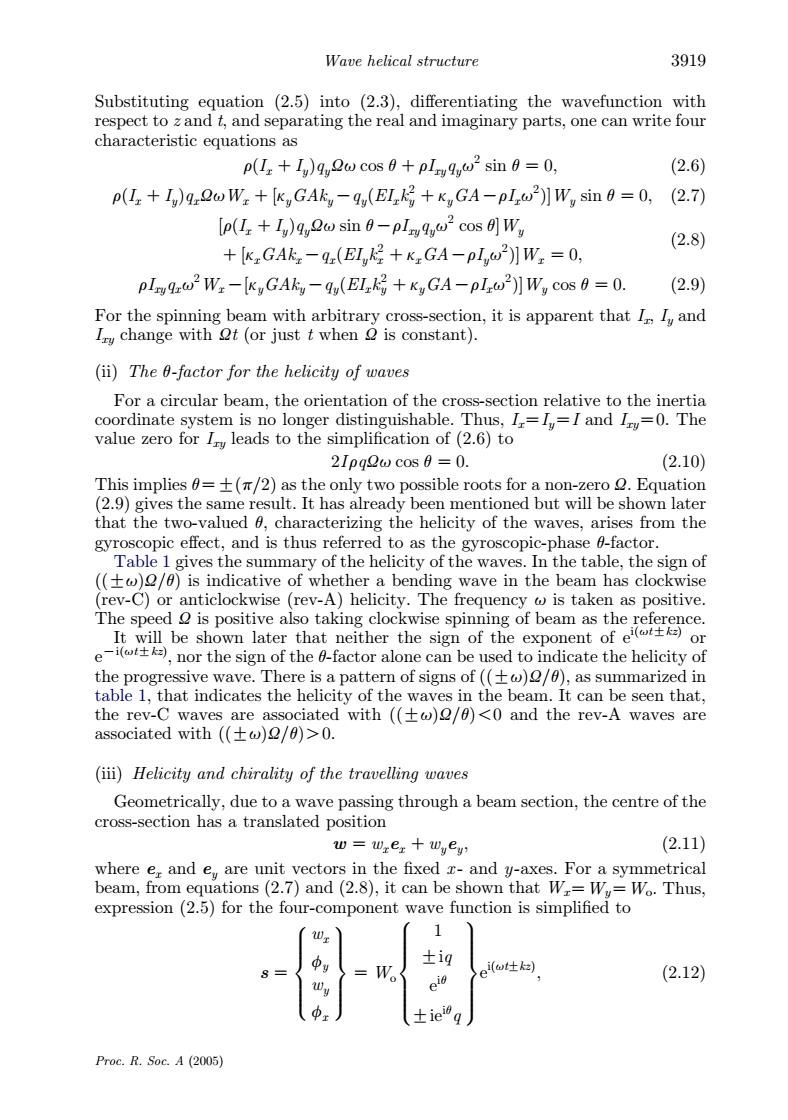正在加载图片...

Wave helical structure 3919 Substituting equation (2.5)into (2.3),differentiating the wavefunction with respect to z and t,and separating the real and imaginary parts,one can write four characteristic equations as (I+)qy2 cos 0+plry g2sin=0, (2.6) p(I Iv)qQoW:[KyGAky-qy(EI ky KyGA-pI2)]Wy sin 0 =0, (2.7) [p(I+I)q20 sin 0-pI cos Wy (2.8) [K GAk:-qr(EI ki+KGA-pIy2)]W:=0, pIryq2W:-[Ky GAky-qu(EIky +Ky GA-pI2)]Wy COs 0 =0. (2.9) For the spinning beam with arbitrary cross-section,it is apparent that II and I change with Ot (or just t when 2 is constant). (ii)The 0-factor for the helicity of waves For a circular beam,the orientation of the cross-section relative to the inertia coordinate system is no longer distinguishable.Thus,I=I=I and I=0.The value zero for Ir leads to the simplification of(2.6)to 2IpgQw cos 0 =0. (2.10) This implies =+(/2)as the only two possible roots for a non-zero 2.Equation (2.9)gives the same result.It has already been mentioned but will be shown later that the two-valued 6,characterizing the helicity of the waves,arises from the gyroscopic effect,and is thus referred to as the gyroscopic-phase 0-factor. Table 1 gives the summary of the helicity of the waves.In the table,the sign of (()/0)is indicative of whether a bending wave in the beam has clockwise (rev-C)or anticlockwise (rev-A)helicity.The frequency w is taken as positive. The speed Q is positive also taking clockwise spinning of beam as the reference. It will be shown later that neither the sign of the exponent of e or e-i,nor the sign of the 0-factor alone can be used to indicate the helicity of the progressive wave.There is a pattern of signs of (()/0),as summarized in table 1,that indicates the helicity of the waves in the beam.It can be seen that, the rev-C waves are associated with (()/)<0 and the rev-A waves are associated with (()20)>0. (iii)Helicity and chirality of the travelling waves Geometrically,due to a wave passing through a beam section,the centre of the cross-section has a translated position w=Wrer Wyeyr (2.11) where e,and e are unit vectors in the fixed x-and y-axes.For a symmetrical beam,from equations (2.7)and (2.8),it can be shown that Wr=W=Wo.Thus, expression (2.5)for the four-component wave function is simplified to ±iq 8 = W。 ei(wt吐) (2.12) ±ieq Proc.R.Soc.A (2005)Substituting equation (2.5) into (2.3), differentiating the wavefunction with respect to z and t, and separating the real and imaginary parts, one can write four characteristic equations as rðIx CIyÞqyUu cos q CrIxyqyu 2 sin q Z 0; ð2:6Þ rðIx CIyÞqxUuWx C½kyGAkyKqyðEIx k2 y CkyGAKrIxu 2 ÞWy sin q Z0; ð2:7Þ ½rðIx CIyÞqyUu sin qKrIxyqyu 2 cos qWy C½kxGAkxKqx ðEIyk2 x CkxGAKrIyu 2 ÞWx Z 0; ð2:8Þ rIxyqxu 2 WxK½kyGAkyKqyðEIx k2 y CkyGAKrIxu 2 ÞWy cos q Z 0: ð2:9Þ For the spinning beam with arbitrary cross-section, it is apparent that Ix, Iy and Ixy change with Ut (or just t when U is constant). (ii) The q-factor for the helicity of waves For a circular beam, the orientation of the cross-section relative to the inertia coordinate system is no longer distinguishable. Thus, IxZIyZI and IxyZ0. The value zero for Ixy leads to the simplification of (2.6) to 2IrqUu cos q Z0: ð2:10Þ This implies qZG(p/2) as the only two possible roots for a non-zero U. Equation (2.9) gives the same result. It has already been mentioned but will be shown later that the two-valued q, characterizing the helicity of the waves, arises from the gyroscopic effect, and is thus referred to as the gyroscopic-phase q-factor. Table 1 gives the summary of the helicity of the waves. In the table, the sign of ((Gu)U/q) is indicative of whether a bending wave in the beam has clockwise (rev-C) or anticlockwise (rev-A) helicity. The frequency u is taken as positive. The speed U is positive also taking clockwise spinning of beam as the reference. It will be shown later that neither the sign of the exponent of ei(utGkz) or e Ki(utGkz) , nor the sign of the q-factor alone can be used to indicate the helicity of the progressive wave. There is a pattern of signs of ((Gu)U/q), as summarized in table 1, that indicates the helicity of the waves in the beam. It can be seen that, the rev-C waves are associated with ((Gu)U/q)!0 and the rev-A waves are associated with ((Gu)U/q)O0. (iii) Helicity and chirality of the travelling waves Geometrically, due to a wave passing through a beam section, the centre of the cross-section has a translated position w Zwxex Cwyey; ð2:11Þ where ex and ey are unit vectors in the fixed x - and y-axes. For a symmetrical beam, from equations (2.7) and (2.8), it can be shown that WxZWyZWo. Thus, expression (2.5) for the four-component wave function is simplified to s Z wx fy wy fx 8 >>>< >>>: 9 >>>= >>>; Z Wo 1 Giq eiq Gieiq q 8 >>>>< >>>>: 9 >>>>= >>>>; e iðutGkzÞ ; ð2:12Þ Wave helical structure 3919 Proc. R. Soc. A (2005)